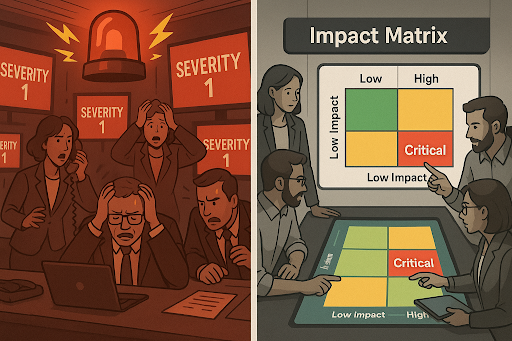In today’s hyper-connected world, a security breach or operational failure can cascade into reputational, financial, and regulatory calamities within minutes. Yet too many organizations cling to time-based escalation models—waiting predetermined intervals before engaging senior leaders. This lag leaves decision-makers blind until damage is already underway.
Impact-based escalation flips that script. It empowers teams to elevate incidents according to real-time assessments of harm to people, revenue, brand, or compliance. For executives, this approach aligns response authority with business priorities, ensuring crises get the appropriate attention at the precise moment it matters most.
The Limits of Time-Driven Escalation
Traditional escalation matrices trigger leadership involvement after fixed delays (for example, 30 minutes of downtime or 60 minutes of investigation). While simple to define, this method:
- Fails to account for severity – 30 minutes of minor customer inconvenience differs vastly from 5 minutes of stolen personal data.
- Encourages “wait and see” mindsets – teams may defer escalation until time thresholds are met, compounding risk.
- Misaligns stakeholder engagement – executive bandwidth is squandered on low-impact events or withheld for critical ones.
As business models digitize and threat actors accelerate, time-driven protocols simply can’t keep pace.
Embracing Impact-Based Escalation
Impact-based escalation triggers are anchored in measurable harm rather than elapsed minutes. By mapping incident characteristics to strategic risk dimensions, organizations ensure the right people act immediately when stakes rise.
Defining Your Impact Dimensions
Executives should align escalation with the areas they care about most:
- Safety & Well-Being: Threats to employee or customer life and health
- Financial Exposure: Revenue at risk, cost of remediation, potential fines
- Reputational Damage: Media coverage, social-media sentiment, customer churn
- Regulatory & Legal: Compliance breaches, litigation risk, contractual penalties
- Operational Continuity: Service-level degradation, supply-chain disruption
Mapping Impact to Escalation Tiers
Translate each dimension into thresholds that demand escalating attention. A sample matrix:
| Impact Level | Safety Risk | Financial Exposure | Reputation | Escalation Action |
| Low | First-aid injury | <$10 K potential loss | Local social chat | Frontline support (Tier 1) |
| Medium | Hospitalization risk | $10 K–$100 K at stake | Regional coverage | Incident response team (Tier 2) |
| High | Life-threatening risk | >$100 K potential loss | National headlines | Executive crisis council (Tier 3) |
Each threshold must be quantitative where possible. For reputation, leverage real-time brand-monitoring tools to quantify sentiment shifts.
Building an Impact-Based Escalation Framework
Moving from concept to practice requires:
- Governance Alignment – Embed escalation criteria in your risk-management charter and policies. – Secure board or executive committee sign-off on impact definitions and decision authorities.
- Roles & RACI Clarity – Document who assesses impact, who decides on escalation, and who must be informed. – Maintain real-time contact rosters with secondary backups for each role.
- Automated Monitoring & Alerts – Integrate operational metrics, security telemetry, customer-experience data, and external news feeds into unified dashboards. – Configure automated alerts that classify events by impact dimension and dispatch them to the appropriate channels instantly.
- Standardized Communication Templates – Develop message templates covering: current impact assessment, actions taken, next steps, and responsible owners. – Use secure, tier-specific channels (chat ops for Tier 1, war-room video for Tier 2, executive broadcast for Tier 3).
- Playbooks & Runbooks – For each impact combination, predefine a concise set of actions—technical containment, stakeholder notifications, legal consultations, media statements. – Ensure runbooks link directly to impact triggers to eliminate ambiguity under pressure.
Empowering the Workforce Through Training
A robust framework is only as effective as its users:
- Table-Top Exercises – Simulate high-impact scenarios—ransomware coupled with regulatory fines, or a data leak amid executive travel. – Test decision-making speed, communication flows, and playbook relevance.
- Cross-Functional Drills – Involve IT, legal, HR, communications, and supply-chain teams to surface interdependencies. – Evaluate whether impact triggers spurred the right mix of expertise at each escalation tier.
- After-Action Reviews – Within 48 hours of real or simulated incidents, convene stakeholders to assess: • Accuracy of impact assessments • Speed of escalation • Effectiveness of response playbooks – Assign clear owners for each improvement action, with deadlines tracked in your enterprise risk system.
Strategic Benefits for Executives
Adopting impact-based escalation yields tangible advantages:
- Faster, Smarter Decisions Decision-makers are looped in only when their strategic lens is needed, reducing cognitive overload and enabling targeted interventions.
- Optimized Resource Allocation Critical events draw immediate senior-level focus, while routine incidents remain in operational purview—maximizing leadership efficiency.
- Stronger Board & Regulator Confidence Demonstrable, data-driven escalation thresholds showcase governance maturity and due diligence in risk oversight.
- Enhanced Brand Resilience Proactive, proportional response to high-impact events limits reputational fallout and fosters stakeholder trust.
Next-Generation Opportunities
- AI-Driven Impact Scoring Use machine learning to predict multi-dimensional impact in real time—combining breach footprints, financial models, and media analytics.
- Integrated Crisis Command Centers Fuse physical and virtual war-rooms with live data feeds, stakeholder video links, and decision-support tools to orchestrate end-to-end responses.
- Continuous Improvement via Analytics Leverage post-incident data to recalibrate thresholds and refine playbooks, ensuring the model evolves with shifting threat landscapes.
Taking An Impactful Step
In an era where minutes count and stakes are global, evolving from static, time-based escalation to dynamic, impact-based triggers is no longer optional—it’s imperative. Organizations that embrace this paradigm will outpace threats, safeguard their most vital assets, and fortify the trust of customers, regulators, and boards alike.
Are you ready to make impact—not time—the heartbeat of your crisis response? Our team is here to help you stay ahead of crises.
